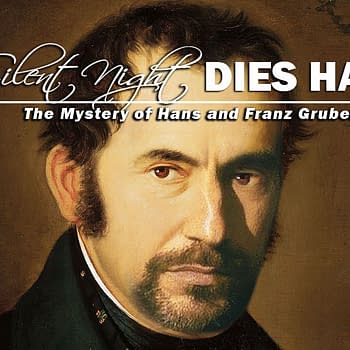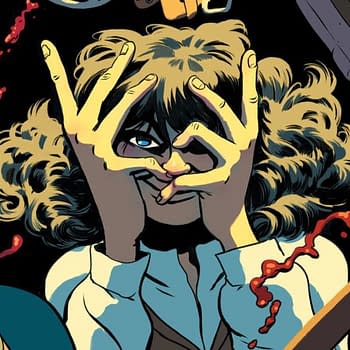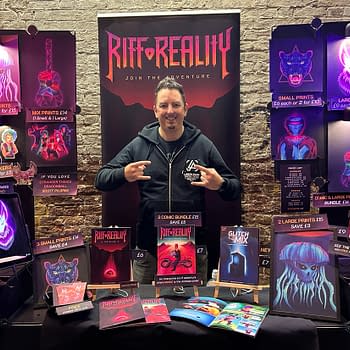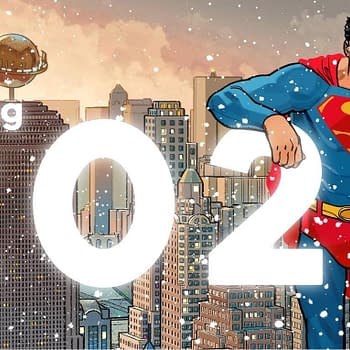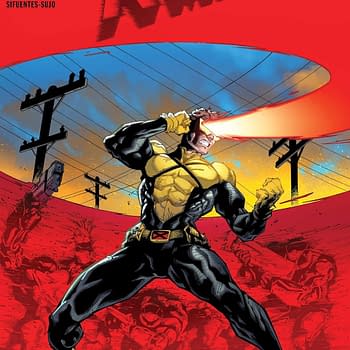Posted in: Comics, Heritage Sponsored, Vintage Paper | Tagged: Black Terror, golden age, Ned Pines, Standard/Better/Nedor
The Black Terror Debuts in Exciting Comics #9, Up for Auction
Created by Richard E. Hughes and David Gabrielsen for 1941's Exciting Comics #9, the Black Terror became Ned Pines' most popular superhero.
Article Summary
- The Black Terror debuts in Exciting Comics #9, a defining superhero of Ned Pines' comic lineup from 1941.
- Created by Richard E. Hughes and David Gabrielsen, Black Terror boasts a memorable skull and crossbones costume.
- Black Terror's alter ego, Bob Benton, a pharmacist, gains super strength from a formic acid formula mishap.
- The iconic cover art by Elmer Wexler cements Exciting Comics #9 as a treasure from the Golden Age of comics.
Debuting in Exciting Comics #9 with a May 1941 cover-date and a February 18, 1941 release date, the Black Terror is perhaps the most popular and best-remembered superhero character from Ned Pines' Standard/Better/Nedor comic book line. The character soon garnered his own series as well as appearances in the anthology title America's Best Comics, and his simple but recognizable costume has helped inspire numerous revivals of the Black Terror in more recent times from various publishers. Created by Richard E. Hughes and David Gabrielsen, and with a cover by Elmer Wexler, there's a CGC VG 2.5 copy of Exciting Comics #9 (Nedor, 1941) featuring the first appearance and origin of the Black Terror up for auction in the 2025 September 18 Golden Age Comics Century Showcase Auction II at Heritage Auctions.
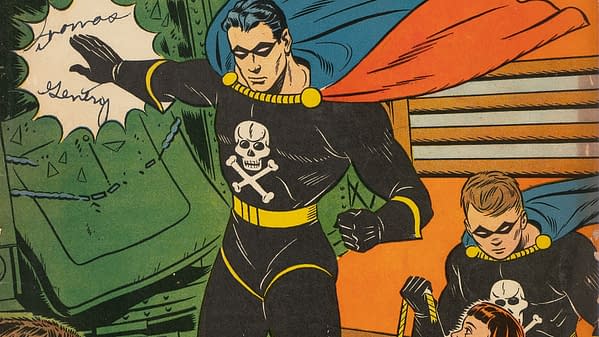
As depicted in his origin story in Exciting Comics #9, The Black Terror's alter ego is very much in the Clark Kent mold. Bob Benton, a mild-mannered pharmacist who even looks like Clark Kent, shrinks away from conflict and is constantly berated by acquaintance Jean Starr for not being able to handle himself. Experimenting with a tonic for "run-down people," Benton accidentally adds formic acid to his formula, and the fumes from the resulting compound give him tremendous strength. His young assistant Tim later breathes the fumes on purpose in order to become the Black Terror's sidekick. While such dangerous and unlikely origins are hardly unusual when it comes to the genesis of comic book superpowers, formic acid fumes can be extremely hazardous and sometimes fatal. As for the skull and crossbones outfit, Tim got it from a theatrical costumer.
Black Terror co-creator Richard E. Hughes had an extensive involvement with the comics of that era and beyond. Working as a writer and editor for Benjamin W. Sangor's comic production studio, Hughes co-created heroes such as Dr. Strange and the Black Terror, and later became the editor of the American Comics Group 1943-1967. At ACG, Hughes co-created the legendary character Herbie Popnecker with Ogden Whitney.
Exciting Comics #9 cover artist Elmer Wexler also drew the cover of the first appearance of Fighting Yank in Startling Comics #10. He worked for a number of comic book publishers in the early Golden Age, including Standard/Better/Nedor, Fawcett, Quality, MLJ, and Columbia. He had previously done pulp illustrations for Street & Smith among others. During WWII, Wexler served as a combat artist for the Marines. The comic strip Vic Jordan, done in collaboration with Kermit Jaedicker and Charles Zerner, is among his best-remembered work.
While very little has been confirmed about the background of Black Terror co-creator David Gabrielsen, a commercial artist of that name who was born in 1917 and lived in the Westchester County, New York area for much of his life would appear to be a likely candidate for the comic book artist who has a tiny handful of comic book credits beyond the debut of the Black Terror in Exciting Comics #9. According to a 1963 newspaper article, this David Gabrielsen apprenticed with important magazine illustrator McClelland Barclay upon graduating high school. He then worked for various art studios and advertising agencies in New York City before striking out on his own, ultimately becoming an advertising executive. He would have been around 24 years old at the time of the creation of the Black Terror story in Exciting Comics #9.
In addition to the first appearance of the Black Terror, this issue also contains the Space Rovers by Max Plaisted, the Mask by Kin Platt, the Sphinx by C.A. Winter, and Jim Hatfield, Texas Ranger. This copy of Exciting Comics #9 has been graded CGC VG 2.5 Cream to off-white pages, and there are 41 entries for Exciting Comics #9 on the CGC census. This issue is currently tied for #100 on Overstreet's list of Top 100 Golden Age Comics, and rated a Gerber "7" or "scarce" on the Photo-Journal Guide to Comic Books' Scarcity Index. Those new to Heritage Auctions should check out their FAQ on the bidding process and related matters.






